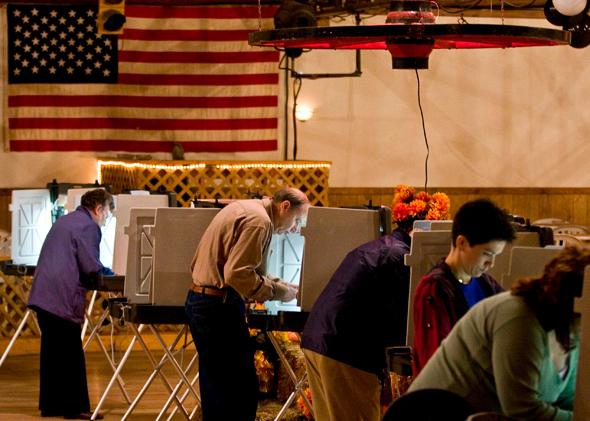A voting rights battle royal began last month when the Department of Justice sued North Carolina over its restrictive new election law. DOJ alleged that the law, which imposes a photo ID requirement for voting, ends same-day voter registration, and cuts back on early voting, violates Section 2 of the Voting Rights Act. Earlier this summer the DOJ also filed two Section 2 suits against Texas, arguing that its photo ID law and electoral district maps are illegal.
Section 2 is the VRA’s core remaining prohibition of racial discrimination in voting. It bans practices that make it more difficult for minority voters to “participate in the political process” and “elect representatives of their choice.” It applies to both redistricting (as in Texas) and voting restrictions (as in North Carolina). And it just became a whole lot more important thanks to the Supreme Court’s June decision in Shelby County v. Holder, which neutered the VRA’s other key provision, Section 5. Section 5 used to bar certain states and cities, mostly in the South, from changing their election laws unless they first received federal approval. To get approval, the jurisdictions had to prove that their changes wouldn’t make minority voters worse off. Now that Section 5 is essentially gone, all eyes are on Section 2.
How effective is Section 2 at protecting minorities’ voting rights compared with Section 5? Surprisingly, there’s not much research out there on this question. To figure out the answer, I analyzed data about all districts in the South and all VRA lawsuits around the country. Here’s the gist of what I found: Section 2 is worse than Section 5 at stopping redistricting that breaks up districts in which minority voters are numerous enough to elect their preferred candidates. But it’s better at blocking voting restrictions than is commonly realized (though not as good as Section 5). My study also suggests ways to amend Section 2 to shore up its weaknesses. The changes I’m proposing, I think, would be less controversial, and more likely to survive a court challenge, than other suggested responses to the Supreme Court’s decision.
At argument last winter, Justice Anthony Kennedy remarked that “it’s not clear to me that there’s that much difference” between Section 2 and Section 5 as to redistricting. It turns out he’s wrong. I found that there are actually dozens of districts in the South (both in Congress and in state legislatures) that Section 5 used to protect, but that states can now eliminate without violating Section 2. That’s because Section 5 used to insulate all districts in which minorities can elect their preferred candidates from any major changes. Section 2, on the other hand, doesn’t apply to districts that are strangely shaped or whose minority populations fall below 50 percent or are too socioeconomically varied. These kinds of districts can now be dismantled with impunity.
In all, there are 167 districts across the South that used to be protected by Section 5 but that are now in jeopardy. Looking state by state, Georgia and Texas lead the pack with about three dozen newly vulnerable districts each. If all of these districts were replaced with ones in which minorities no longer had the electoral power to elect their preferred candidates, as is now possible, many of the gains that blacks and Hispanics have made in recent years would disappear. We’d be back in a world in which successful minority politicians were a rarity.
As a shield against voting restrictions, however, Section 2 looks better than its reputation suggests. I counted 18 wins since 1982 in cases in which minority voters sued over tightened voter registration rules, absentee voting policies, polling place cutbacks, and the like. I also calculated a success rate of about 50 percent in these cases, which is higher than the 40 percent figure for all Section 2 suits. Slate contributor and UC–Irvine law professor Richard Hasen has pointed out that there has yet to be a successful Section 2 challenge to a photo ID law. But only two such challenges have been decided so far (in Arizona and Georgia). And each failed because the plaintiffs couldn’t show that minorities were less likely than whites to possess valid IDs—proof that is now becoming more available. This means that Section 2 should be an increasingly useful weapon against the voting restrictions popping up around the country.
Congress could also strengthen Section 2 in a couple of ways. As to redistricting, lawmakers could amend the provision so that it applied to districts with odd shapes or with minority populations that were relatively small or heterogeneous. The idea would be for Section 2, like Section 5, to protect all districts in which minority voters are capable of electing their preferred candidates. And as to voting restrictions, Congress could make Section 2 a shield whenever a law harmed minority voters more than white voters. Unequal impact used to be enough to block a law under Section 5. It could be made the standard for Section 2 too.
The possibility of amending Section 2 has barely come up since Shelby County was decided. But it should. In fact, there’s a precedent. When the Supreme Court cut back on voting rights in 1980, Congress responded in 1982 by broadening Section 2. What worked for President Ronald Reagan and House Speaker Tip O’Neill might also work for Barack Obama and John Boehner.
